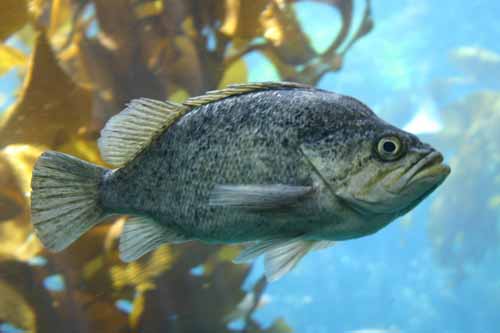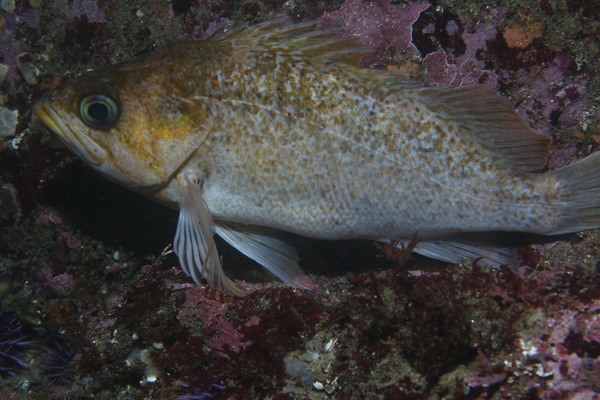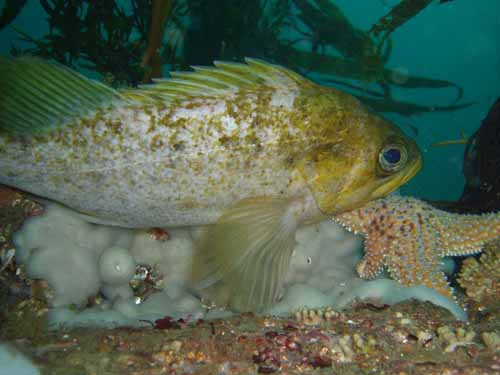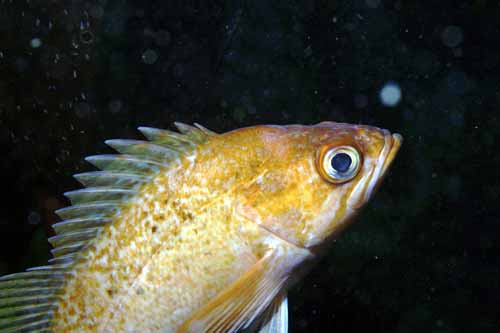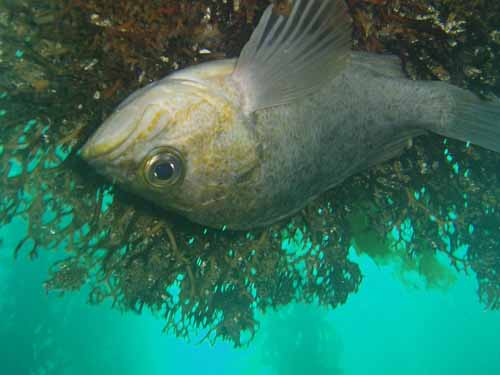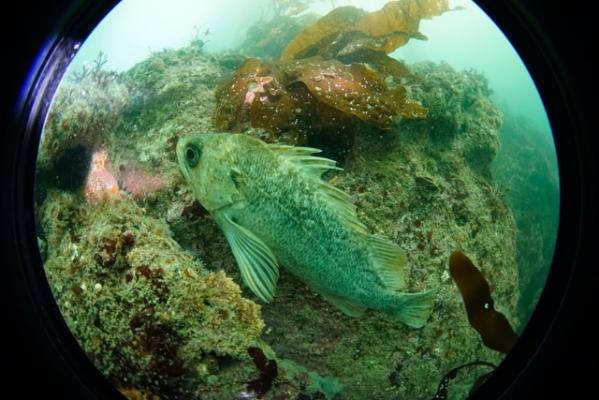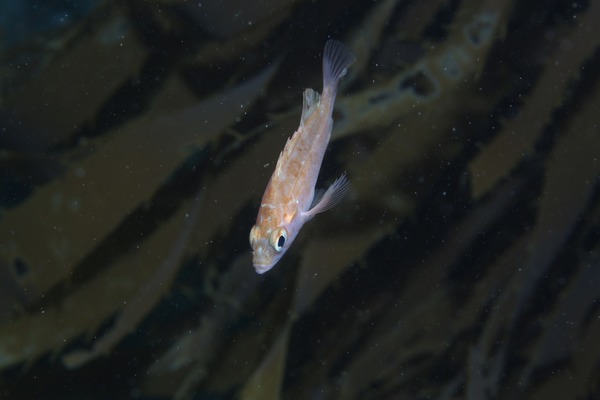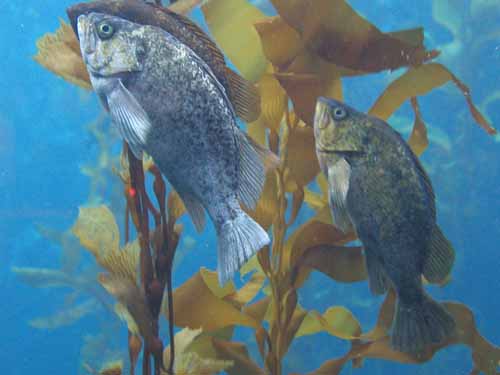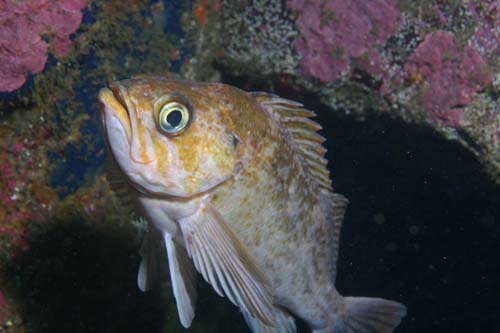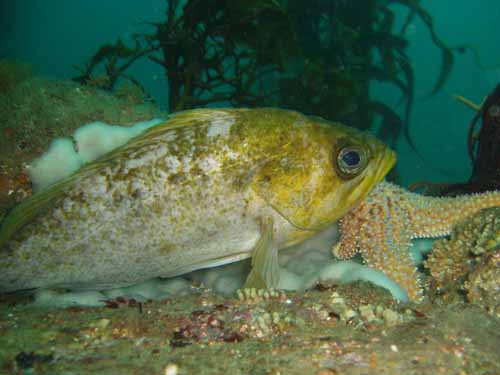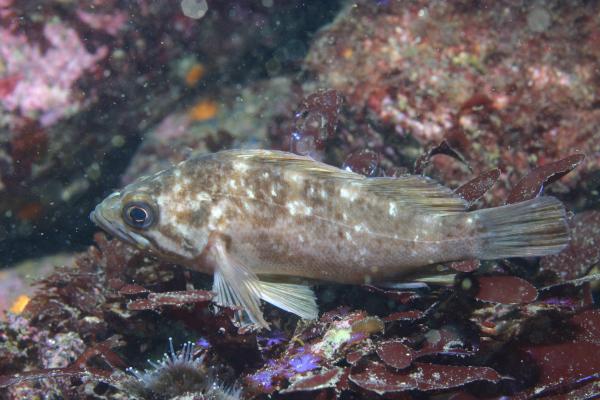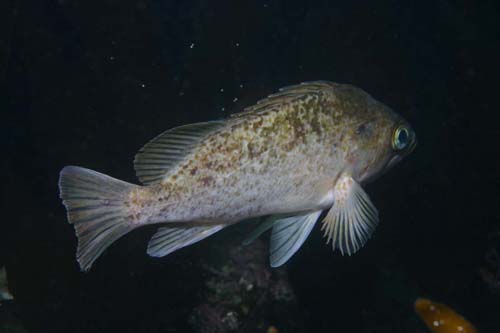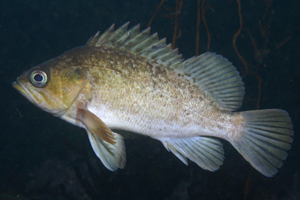
Kelp rockfish
Sebastes atrovirens
Overview
Key Features:
Typical rockfish body shape, but pale yellow or nearly white, with faint light tan mottling, darker towards dorsal fin.Primary Common Name:
Kelp rockfishGeneral Grouping:
Bony fishesGeographic Range:
Timber Cove, California to Punta de San Pablo, Baja California, Mexico
Sebastes atrovirens occurs from Timber Cove, California to Punta de San Pablo, Baja California, Mexico.Northern latitude extent:
38.526221Southern latitude extent:
29.682180Intertidal Height:
0 to 0 feet (0 to 0 meters)Notes:
With the exception of young-of-the-year (YOY), kelp rockfish are not found in tidepools.Subtidal Depth Range:
Minimum Depth: 2 meters or 7 feetMaximum Depth: 46 meters or 153.18 feet
Notes:
Sebastes atrovirens is commonly found in the shallow subtidal, often in kelp forests.Habitats:
bay (rocky shore), exposed rocky shore, kelp forest, protected rocky shoreNotes:
Sebastes atrovirens is found among rocky reefs and kelp beds usually on or just off the bottom. They are most common between 7-20 meters, but can occur to depths of 46 meters.Abundance:
Relative Abundance:
Sebastes atrovirens is common in southern and central California and occasional to uncommon in northern California.Species Description:
General:
Sebastes atrovirens is in the family Sebastidae, shared by all rockfishes, rockcods, and thornyheads. Like many rockfish, Sebastes atrovirens is a spiny, deep-bodied fish, and is usually colored tan or pinkish brown with dark mottling.Distinctive Features:
Sebastes atrovirens has a deep, fusiform, and compressed body. Their body and fin membranes are mottled shades of tan to brown to greenish brown or gray and can occasionally have pink tints. Their snout is moderately sharp and the lower jaw is scaled. They have 5 or more pairs of head spines and no coronal spines. Sebastes atrovirens has long and slender gill rakers on first arch and the caudal fin is rounded. There are 13 dorsal spines and 13-15 dorsal soft rays and these are the same height. There are 3 anal spines, 6-7 anal soft rays, 26 vertebrae and 7 branchiostegal rays.Sebastes atrovirens can often be confused with the grass rockfish, Sebastes rastrelliger, but the latter species has short and stubby gill rakers versus long and slender ones. Sebastes atrovirens is also similar to the brown rockfish, S. auriculatus, but the latter can be distinguished by its coronal spines, the dark blotch on the rear edge of the opercle and the pinkish membranes of the pectoral, pelvic and caudal fins. The grass rockfish, S. rastrelliger is also similar, but can be distinguished by its short, blunt gill rakers on the first arch and its unscaled lower jaw.
Size:
<em>Sebastes atrovirens</em> can grow to 42 cm total length.Natural History:
General:
Sebastes atrovirens can occur alone or in large aggregations. These fish rarely move from place to place, though they might migrate into slightly deeper water or retire to rock caves during winter storms. They can change their color and markings to blend in with their background. Sebastes atrovirens can live to be 20 years old.Predator(s):
Sebastes atrovirens is frequently caught by sport fishermen, particularly between Santa Barbara to northern California. They are seldom taken in commercial fishing operations.Prey:
Sebastes atrovirens feeds on small crabs, shrimps, amphipods, isopods, squids, and some fishes, including juvenile rockfishes.Feeding Behavior:
CarnivoreNotes:
Often found 'hanging' among blades of the giant kelp Macrocystis pyrifera, waiting for smaller fishes to swim within range.Seasonal Behavior
February - May
Reproduction:
Female Sebastes atrovirens reach sexual maturity beginning at age 5 and a size of 21.5 cm. Viviparous spawning takes place from late winter to spring, and juveniles settle out of the plankton into kelp beds in summer, usually from April through August, but earlier in Southern California and Baja. As they grow, Sebastes atrovirens spread out away from the kelp canopy they settled in.References
- Boschung, H.T., J.D. Williams, D.W. Gotshall, D.K. Caldwell, and M.C. Caldwell. 1998. National Audubon Society Field Guide to North American Fishes, Whales and Dolphins. A.A. Knoph, New York, NY. 848 p.
- Eschmeyer, W.N., and E.S. Herald. 1983. A Field Guide to Pacific Coast Fishes of North America. Houghton Mifflin Company, Boston, MA. 336 p.
- Froese, R. and D. Pauly (eds.). 2006 (Updated 01/02/06). FishBase. World Wide Web electronic publication. http://www.fishbase.org, Accessed [04/25/06].
- Gotshall, D. 2001. Pacific Coast Inshore Fishes. Sea Challengers, Monterey, CA. 117 p.
- Humann, P. 1996. Coastal fish identification : California to Alaska. New World Publications, Jacksonville, FL. 205 p.
- Love, M. 1996. Probably more than you want to know about the fishes of the Pacific Coast. Really Big Press, Santa Barbara, CA. 381 p.
- Miller, D.J. and R.N. Lea. 1972. Guide to the coastal marine fishes of California. California Department of Fish and Game, Sacramento, CA.
Related Information
Project Database
Photo Library
Click on an image below to view a larger version in the SIMoN Photo Library. You will also be able to view important information on each photo such as photographer, date, caption and more

